Avoidance is best; treatment is possible

For a significant number of episodic migraine patients, taking painkillers regularly results in a downward spiral that ends with chronic daily or near-daily headaches that do not respond to medication.
Cleveland Clinic is a non-profit academic medical center. Advertising on our site helps support our mission. We do not endorse non-Cleveland Clinic products or services. Policy
The condition, known as medication overuse headache (MOH) or rebound headache, can happen with virtually any type of pain medication, from common analgesics to opioids. And it is a disabling problem.
Fortunately, the cycle can be broken through a medication withdrawal process, sometimes with the help of bridge therapy, Cleveland Clinic headache specialists explain.
Cleveland Clinic specialists stress that it is far better to avoid MOH than to treat it, and they have solid advice in that regard. They also note that when MOH does occur, the consensus is that abrupt withdrawal from pain medications is preferable to a tapered, drawn-out weaning approach.
“The best treatment is to not allow patients to get into this situation in the first place, if at all possible,” states MaryAnn Mays, MD, a neurologist in the Center for Neurological Restoration’s Headache Center and Director of the Neurology Residency Program. She spoke about MOH at Cleveland Clinic Department of Pain Management’s 18th Annual Pain Management Symposium, March 5-9, 2016, in San Diego.
“Second rule: If you do prescribe pain medication, be crystal clear about dosage limitations from the outset and explain why they are important,” Dr. Mays continues. “Acute treatment must absolutely not exceed two days per week.
“Third, if headaches occur six to 10 days or more each month, consider prophylaxis with a daily medication such as topiramate, and using headache-specific medications such as triptans or dihydroergotamine (DHE) to treat headaches when they occur. The latter are likely to work more effectively than non-specific medication such as ibuprofen, and they are not addictive,” Dr. Mays says. She emphasizes again that medications should be used no more than two days a week or maximum 10 days per month. She notes that botulinum toxin (BT) injections are another possible treatment when headaches become chronic in nature (>15 days a month).
“Finally, do not use butalbital or opioids as acute treatment for migraine. Period,” she says.
Physicians can suspect MOH in patients who have a high frequency of migraines (15 or more a month), are more disabled by their headaches than average and don’t respond to abortive or preventive medication, Dr. Mays notes. She adds that combination agents such as Excedrin® pose a greater risk for developing MOH than single-agent medications.
Risk factors for MOH include:
Patients with MOH often report morning headaches (a withdrawal phenomenon from medication), neck pain, interrupted sleep, rhinorrhea or nasal stuffiness, lacrimation and syncope, Dr. Mays notes, adding that most MOH headaches are migrainous and some are tension-type. “Patients with MOH will have good days and bad and are typically not as disabled as those patients with episodic migraine. Presentation might seem complex, but all of these symptoms might be tied to rebound,” she adds.
“The main thing is to develop a plan, with the patient, to withdraw medications over time, or immediately if the patient feels comfortable doing so,” Dr. Mays says, acknowledging that headaches will generally worsen for a week or two after abrupt withdrawal, but then will continue to improve over the next several months.
“Patients who tackle it head on seem to do best,” Dr. Mays contends. “You tell them your recommendation and they go home and throw out the Excedrin bottle. The reward is feeling better faster. You can offer a 10 percent wean per week, but that just drags it out. Explaining how discontinuing medications will help MOH symptoms – sleep, anxiety, depression, sinus congestion – is very important, as is being honest and direct about the likely cause of their headaches.”
In the vast majority of cases, the withdrawal process doesn’t require inpatient treatment or even a specialist, she notes.
Bridge therapy, using DHE, steroids, IV medications such as magnesium or valproate sodium, can be used for patients struggling to break the cycle or taking high doses of opioids, barbiturates or butalbital, she adds.
“Bridge treatments can help span the gap between short-term suffering and long-term improvement,” says Jianguo Cheng, MD, PhD, of the Departments of Pain Management and Neurosciences, and Director of the Cleveland Clinic Pain Medicine Fellowship Program. “This can smooth the transition for patients with emotional or psychological responses to withdrawal.”
BT injections can be administered to several locations, depending on whether the headache is migrainous, cervicogenic or related to the temporomandibular joint (TMJ), Dr. Cheng says. “If you relax the muscle by injecting a small amount of BT, the patient will have short-term pain relief that may last a few weeks or a few months. This will help the patient tremendously as she/he goes from chronic use of painkillers to less frequent or no use.”
Blocking the occipital, temporal, supraorbital or temporal nerve may provide a similar benefit, Dr. Cheng continues, adding that both BT and nerve blocks can be repeated for responders.
For the patient with chronic pain due to fibromyalgia or arthritis, for example, coupled with migraine, the scenario becomes trickier, explains Dr. Cheng, who, as Vice President for Scientific Affairs, chairs the American Academy of Pain Medicine Task Force on NIH Interagency Pain Research Coordinating Committee-Federal Pain Research Strategy as part of the National Pain Strategy. MOH in this population requires medication withdrawal and alternate treatments that range from lifestyle changes to nonpharmacological treatments. The latter include physical, occupational or cognitive-behavioral therapy. Interventional approaches such as radiofrequency ablation or other minimally invasive procedures may be indicated to address various chronic pain conditions.
“For those with serious anxiety about developing a headache during withdrawal,” Dr. Mays says, “seeing a psychologist, using ice or heat, even taking a break or a nap, can help abort a headache.” She encourages practitioners to listen carefully to patients and for patients to work hard on areas they can improve, such as sleep hygiene, stress reduction, exercise, losing weight and better nutrition (i.e., avoiding processed foods).
For 70 to 90 percent of patients, headaches will improve with medication withdrawal. However, the relapse rate is high – up to 40 percent, Dr. Mays cautions, adding, “Physicians need to emphasize to patients that they can’t fall back into old patterns and habits. We must make sure patients understand that medication – no matter what type – cannot be taken more than two days a week.
“Both clinicians and patients are more aware of medication overuse headaches now,” Dr. Mays concludes, “and primary care physicians in particular are taking a more active role in the treatment of this vexing problem. They know that setting clear limits on the use of any type of pain reliever is crucial. That is a good thing.”
Tepper SJ, Tepper DE. Breaking the cycle of medication overuse headache.
Cleve Clin J Med. 2010Apr;77(4):236-42.

Program enhances cooperation between traditional and non-pharmacologic care

Pain specialists can play a role in identifying surgical candidates

Clinical judgment is foundational to appropriately prescribing

The device is a less invasive alternative for patients who are struggle with chronic pain

The Four Pillar Project provides physicians with evidence-based talking points to quickly identify problem areas and educate patients to optimize important aspects of their health.

When conservative approaches don’t work, it may be time to turn to sacroplasty

Fourth iteration of the guidelines focuses on high-risk patient identification and evidence on newer drugs

It is a lifestyle commitment that can minimize pain and improve lives